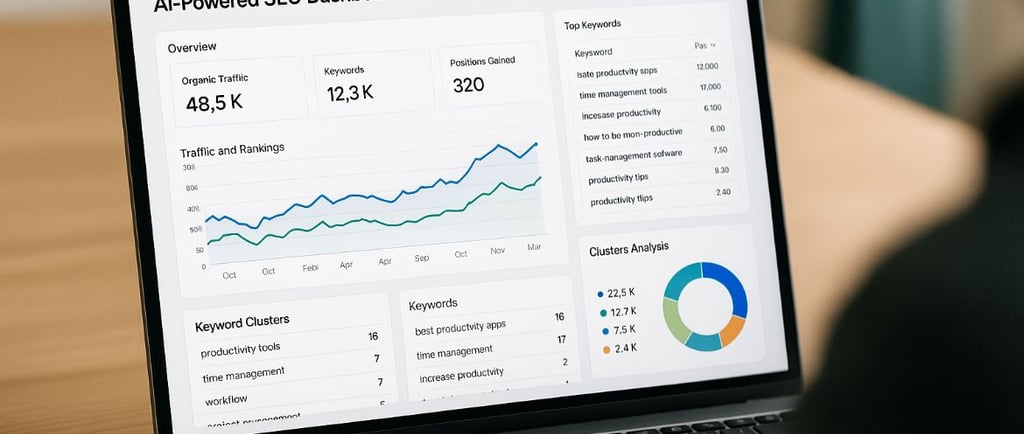
Master Tech skills on the go...
How to Use AI for Keyword Research and SEO Optimization
Discover How to Use AI for Keyword Research and SEO Optimization: semantic clustering, content briefs, on-page and technical SEO to boost rankings with automation.
AI TOOLS & PROMPT ENGINEERING
By OnlineTechSkills Editorial Team
5/8/20255 min read


In the ever-evolving landscape of digital marketing, leveraging artificial intelligence (AI) for keyword research and SEO optimization isn’t just a convenience, it’s a necessity. AI-driven tools can sift through mountains of data, uncover hidden patterns, and suggest high-impact keywords far beyond what manual research alone can achieve. This article offers a comprehensive, step-by-step guide to harnessing AI for keyword discovery, content optimization, and performance monitoring. We’ll walk through best practices, share actionable techniques, and introduce you to essential AI-powered tools.
1. Why AI Transforms Keyword Research
Traditional keyword research relies heavily on manual brainstorming, limited keyword planners, and gut instinct. AI changes this by:
Data-Driven Insights: AI analyzes billions of search queries, click-through rates, and user behavior signals to identify terms with real potential.
Semantic Understanding: Natural Language Processing (NLP) models grasp context, clustering keywords by intent and meaning rather than just surface match.
Predictive Capabilities: Machine learning forecasts shifts in search trends, helping you stay ahead of emerging topics.
By integrating AI early in your SEO workflow, you unlock deeper research, faster iteration, and content that truly resonates.
2. Essential AI-Powered Keyword Tools
Here are some must-have AI tools to kickstart your research:
ChatGPT and GPT-4: Use prompt engineering to generate broad seed lists and long-tail variations. Learn more about mastering prompts in A Beginner’s Guide to Prompt Engineering with AI Tools.
Ahrefs’ Keywords Explorer: Its AI-driven “Content Gap” and “Keyword Ideas” features reveal competitor gaps and untapped queries.
Semrush Keyword Magic: Offers AI-powered topic clusters and related questions for comprehensive coverage.
Surfer SEO: Combines NLP with on-page auditing to suggest keywords and content structure.
AnswerThePublic: Visualizes audience questions and prepositions by mining forums and search suggest.
Pairing these tools yields both breadth and precision from high-volume head terms to niche, intent-driven phrases.
3. Step 1: Generating Seed Keywords with AI Prompts
Begin with high-level thematic prompts in ChatGPT or similar. For instance:
“List 20 keywords related to ‘organic skincare routine for sensitive skin,’ categorized by search intent.”
Actionable Steps:
Define Your Topic Scope: Be as specific as possible to guide the AI.
Iterate Prompts: Refine by asking for “long-tail medical-grade product” or “morning vs evening routine.”
Export Results: Copy the AI-generated lists into a spreadsheet for further analysis.
This approach yields hundreds of seed ideas in minutes, far outpacing manual brainstorming.
4. Step 2: Expanding and Filtering with AI Analytics
With seed terms in hand, feed them into an AI-powered analytics tool:
Volume and Difficulty: Use Semrush’s API to fetch monthly search volumes and SEO difficulty scores.
Trend Prediction: Ahrefs’ AI predicts whether search interest for each term will rise or fall.
Intent Classification: Tools like Frase.io automatically tag keywords as informational, transactional, navigational, or commercial.
Example Workflow:
Paste your seed list into Semrush’s Keyword Magic.
Filter by volume > 200 and difficulty < 50.
Export the filtered list along with CPC and trend data.
This narrows thousands of entries down to a manageable set of high-opportunity keywords.
5. Step 3: Semantic Clustering and Topic Mapping
Semantic clustering groups related keywords into topical silos. This ensures comprehensive coverage and avoids keyword cannibalization.
Use AI Clustering Tools: Platforms like Topic Clusterer apply NLP to group synonyms and contextually linked terms.
Visualize Clusters: Export clusters into mind-mapping software to outline pillar pages and subtopics.
Assign Intent: Label each cluster by primary intent (e.g., “How to,” “Best X,” “Comparison”).
Clusters can guide content architecture, internal linking, and pillar-post strategies. For a deeper dive on content structuring, check out How to Use Notion to Organize Your Freelance Business for organizational inspiration.
6. Step 4: AI-Driven Content Brief Creation
AI can draft comprehensive content briefs that outline headings, target keywords, FAQs, and recommended word counts.
Surfer SEO: Generates data-backed briefs with heading suggestions and ideal keyword density.
Clearscope: Recommends semantically related terms and competitor word-count analysis.
MarketMuse: Prioritizes topics by content score gaps against top-ranking pages.
Actionable Steps:
Input your target keyword cluster into the brief-generation tool.
Review suggested H2/H3 headings and add or remove based on your unique angle.
Collect the brief and share with writers or stakeholders.
A solid AI brief accelerates content creation while ensuring SEO best practices are baked in.
7. Step 5: Crafting and Optimizing Content
When writing, combine human creativity with AI assistance:
ChatGPT for Drafting: Use fine-tuned prompts to generate a first draft of sections. Then refine tone and clarity manually.
Grammarly Go: AI-driven grammar and style suggestions ensure readability.
Wordtune or Jasper: Help rephrase sentences for engagement and variation.
On-Page Optimization:
Title Tags and Meta Descriptions: Tools like AISEO.io suggest optimized snippets that boost click-through rates.
Image ALT Text: Invoke AI to generate descriptive, keyword-rich alt text.
Internal Linking: Use insights from your semantic clusters to link pillar to satellite pages naturally.
For more free tools to aid this process, explore Best Free AI Tools for Content Creation.
8. Step 6: Technical SEO with AI
Technical health is crucial for rankings. AI tools can audit and suggest fixes:
DeepCrawl or Botify: Identify broken links, duplicate content, and crawl errors using automated site crawls.
Google Lighthouse CLI with AI Plugins: Run performance audits locally and interpret results through AI-driven summaries.
Schema Markup Generators: Tools like SchemaApp use AI to recommend and generate JSON-LD for FAQs, breadcrumbs, and product data.
Actionable Steps:
Schedule weekly AI-driven audits to catch regressions early.
Automate JSON-LD injection via your CMS or tag manager.
Monitor Core Web Vitals; AI platforms can pinpoint problematic resources and suggest optimizations.
9. Step 7: Off-Page SEO and AI-Powered Outreach
Building quality backlinks remains a cornerstone of SEO. AI streamlines prospecting and outreach:
Link-able Asset Ideation: Use AI brainstorming (e.g., ChatGPT) to conceive interactive tools, infographics, or research studies.
Prospect Identification: Tools like Pitchbox or NinjaOutreach employ AI to score domains by topical relevance and authority.
Personalized Outreach: AI-powered email assistants craft tailored pitches at scale, using prospect data to increase reply rates.
Example Workflow:
Generate a “Skyscraper” content idea with AI.
Use Ahrefs to find referring domains to similar articles.
Draft customized outreach templates with AI (e.g., “I noticed your post on X—thought you might love our data-driven [asset]…”).
10. Step 8: Performance Tracking with Machine Learning
Actionable metrics turn insights into growth:
Google Analytics 4 + BigQuery: Export data and apply machine learning models to detect anomalies in traffic or conversion rates.
Clearscope or MarketSmith: Continuously monitor SERP feature wins and losses, alerting you when rankings shift.
Custom Dashboards: Build dynamic dashboards with AI-driven natural language summaries (e.g., “Organic traffic for pillar X increased by 15% after adding cluster content.”)
Regular, automated reporting ensures you react swiftly to algorithm changes and emerging user trends.
11. Advanced AI Techniques and Future Trends
Stay ahead by experimenting with:
GPT Embeddings for Semantic Search: Enhance on-site search by indexing content vectors, improving internal discovery and dwell time.
AI-Powered Voice Search Optimization: Analyze and optimize for conversational queries likely to be spoken versus typed.
Predictive Content Planning: Leverage time-series forecasting models to plan content calendars around anticipated trending topics.
As AI continues to mature, integrating these cutting-edge techniques will keep your SEO strategy resilient and innovative.
12. Practical Tips and Common Pitfalls
Avoid Over-Reliance: AI is a force multiplier, not a replacement for human insight. Always review AI suggestions for brand voice and factual accuracy.
Manage Costs: Some AI APIs incur significant fees at scale set usage limits and explore open-source alternatives like GPT-Neo or Bloom for research phases.
Prioritize Data Privacy: When processing user data through AI tools, ensure compliance with GDPR and other regulations.
Conclusion
Harnessing AI for keyword research and SEO optimization offers a powerful competitive advantage. From generating seed keywords and clustering topics to crafting content briefs and automating outreach, AI accelerates every stage of the SEO process. By combining the strengths of human creativity with machine driven insights, you can build content that ranks, drives traffic, and resonates with your audience.
Ready to deepen your technical skillset? Discover Top 7 Tech Skills to Learn in 2025—No Experience Needed and transform your career trajectory today.
Insights
Explore our free and top ranking blogs for in-demand tech skills.
CONTACT US
Support
support@onlinetechskills.com
© 2025. All rights reserved.